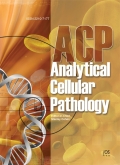Authors: Yang, Nan | Nijhuis, Esther R. | Volders, Haukeline H. | Eijsink, Jasper J.H. | Lendvai, Ágnes | Zhang, Bo | Hollema, Harry | Schuuring, Ed | Wisman, G. Bea A. | van der Zee, Ate G.J.
Article Type:
Research Article
Abstract:
Objectives: To determine methylation status of nine genes, previously described to be frequently methylated in cervical cancer, in squamous intraepithelial lesions (SIL). Methods: QMSP was performed in normal cervix, low-grade (L)SIL, high-grade (H)SIL, adenocarcinomas and squamous cell cervical cancers, and in corresponding cervical scrapings. Results: Only CCNA1 was never methylated in normal cervices and rarely in LSILs. All other genes showed methylation in normal cervices, with CALCA, SPARC and RAR-β2 at high levels. Methylation frequency of 6 genes (DAPK, APC, TFPI2, SPARC, CCNA1 and CADM1) increased with severity of the underlying cervical lesion. DAPK showed the highest
…increase in methylation frequency between LSIL and HSIL (10% vs. 40%, p<0.05), while CCNA1 and TFPI2 were most prominently methylated in cervical cancers compared to HSILs (25% vs. 52%, p<0.05, 30% vs. 58%, p<0.05). CADM1 methylation in cervical cancers was related to depth of invasion (p<0.05) and lymph vascular space involvement (p<0.01), suggesting a role in invasive potential of cervical cancers. Methylation ratios in scrapings reflected methylation status of the underlying lesions (p<0.05). Conclusion: Methylation of previously reported cervical cancer specific genes frequently occurs in normal epithelium. However, frequency of methylation increases during cervical carcinogenesis, with CCNA1 and DAPK as the best markers to distinguish normal/LSIL from HSIL/cancer lesions.
Show more
Keywords: Methylation, cervical (intraepithelial) neoplasia, DAPK, CCNA1, CADM1
DOI: 10.3233/CLO-2009-0510
Citation: Analytical Cellular Pathology,
vol. 32, no. 1-2, pp. 131-143, 2010
Price: EUR 27.50





